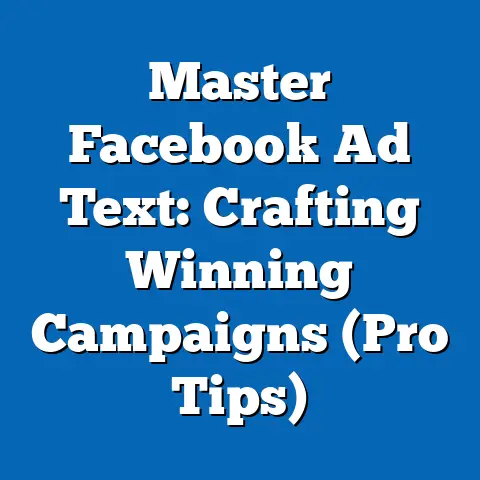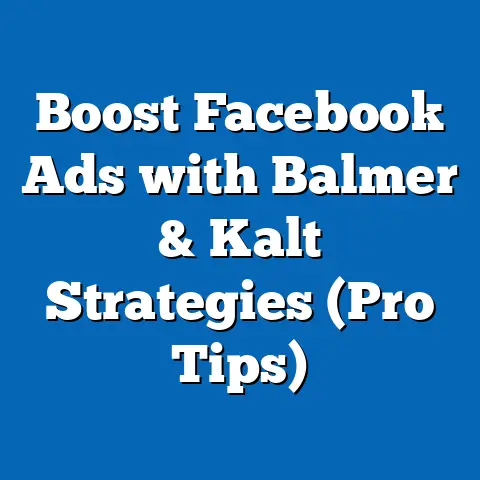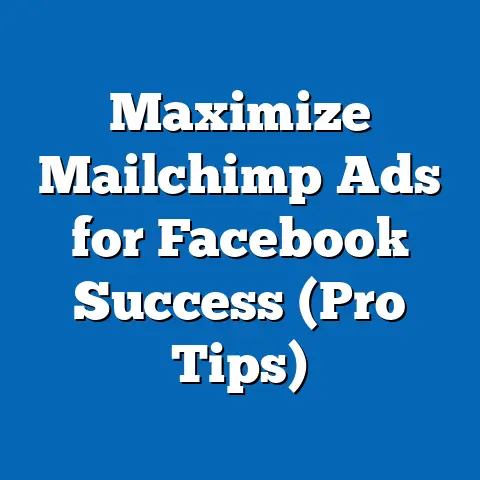Decoding Facebook Ad Costs (Essential Guide for Marketers)
Ever wondered how some brands manage to achieve astounding ROI on Facebook ads while others struggle to break even? I’ve been there, staring at the Ads Manager dashboard, feeling like I’m throwing money into a black hole. What if I told you that understanding the nuances of Facebook ad costs could be the game-changer your marketing strategy needs? It’s not about magic; it’s about mastery of the platform.
Facebook advertising, with its billions of users, remains a powerhouse for marketers. Yet, navigating its complex cost structure can feel like deciphering an ancient scroll. That’s why I’ve created this guide – to unravel the mystery behind Facebook ad pricing, empowering you to make informed decisions and optimize your advertising budgets effectively. This isn’t just about saving money; it’s about maximizing your impact.
1. The Basics of Facebook Ad Costs
Let’s start with the foundational terms. Facebook ad costs aren’t a monolithic entity; they’re built upon several key metrics. Understanding these is the first step to controlling your budget.
- Cost Per Click (CPC): This is the amount you pay each time someone clicks on your ad. It’s a direct measure of how engaging your ad is to your target audience. If people are clicking, your message is resonating.
- Cost Per Thousand Impressions (CPM): This is the cost you pay for every 1,000 times your ad is shown. CPM is crucial for brand awareness campaigns where the goal is to get your message in front of as many eyes as possible.
- Cost Per Action (CPA): This is the cost you pay for a specific action taken by a user, such as a purchase, lead generation, or app install. CPA is often the most critical metric for businesses focused on conversions.
To illustrate, let’s say you’re running an ad campaign to promote a new e-book. If your CPC is \$0.50, and you get 100 clicks, you’ve spent \$50. If your CPM is \$5, and your ad is shown 10,000 times, you’ve spent \$50. Finally, if your CPA for e-book downloads is \$2, and you get 50 downloads, you’ve spent \$100.
The key takeaway here is that these metrics are interconnected and influenced by various factors. A low CPC might not mean success if your CPA is high, indicating that people are clicking but not converting.
Takeaway: Understand the basic cost metrics (CPC, CPM, CPA) and how they relate to your campaign goals.
2. Factors Influencing Facebook Ad Costs
Now, let’s dive into the variables that can make your Facebook ad costs fluctuate like the stock market. I’ve learned through trial and error that understanding these factors is crucial for staying within budget and achieving desired results.
Audience Targeting
The narrower your target audience, the higher your costs can be. Why? Because you’re competing with other advertisers targeting the same specific group. I remember once targeting a very niche group of “left-handed graphic designers who love cats” – my costs skyrocketed! Broadening your audience slightly can sometimes lead to lower costs, but it’s a balancing act.
- Demographics: Age, gender, location, education level – these all play a role.
- Interests: Targeting based on interests can be effective, but be mindful of overlap with other advertisers.
- Behaviors: Facebook tracks user behaviors, like purchase history and device usage. This can be powerful, but also expensive if you’re targeting a highly sought-after behavior.
Tip: Experiment with different audience combinations to find the sweet spot between reach and cost. Don’t be afraid to A/B test different targeting options.
Ad Quality and Relevance
Facebook rewards high-quality, relevant ads with lower costs and better placement. This is where creativity and understanding your audience truly pay off. Your ad quality score is based on factors like:
- Relevance: How well your ad matches the interests of your target audience.
- Engagement: How people are reacting to your ad (likes, comments, shares).
- Landing Page Experience: How relevant and user-friendly your landing page is.
Tip: Use high-quality visuals, write compelling copy that speaks directly to your audience, and ensure your landing page is optimized for conversions. A/B test different ad creatives and copy to see what resonates best.
Bidding Strategies
Facebook offers various bidding options, and choosing the right one can significantly impact your costs.
- Automatic Bidding: Facebook automatically sets your bids to get the most results for your budget. This is a good option for beginners, but it can sometimes lead to higher costs.
- Manual Bidding: You set your own bids, giving you more control over your costs. This requires more expertise but can be more cost-effective if done right.
Tip: Start with automatic bidding to get a sense of the average costs for your target audience. Then, experiment with manual bidding to see if you can lower your costs while maintaining results.
Ad Placement
Where your ad appears on Facebook (e.g., news feed, stories, right column) can also affect pricing. Some placements are more competitive than others.
- News Feed: Generally the most expensive placement, but also the most effective.
- Stories: Often cheaper than the news feed, and a great option for visual content.
- Right Column: Less engaging than other placements, but can be a good option for retargeting.
Tip: Test different placements to see which ones perform best for your target audience and budget.
Competition and Market Trends
Facebook ad costs fluctuate based on supply and demand. During peak seasons like holidays, costs tend to increase as more businesses are advertising.
Tip: Plan your campaigns in advance and be prepared to adjust your bids during peak seasons. Consider running evergreen campaigns that are always relevant to your audience.
Takeaway: Facebook ad costs are influenced by audience targeting, ad quality, bidding strategies, ad placement, and market competition.
3. Understanding the Facebook Ad Auction
The Facebook ad auction is the engine that drives ad delivery and pricing. It’s a real-time bidding system where advertisers compete for ad space based on a combination of factors.
Here’s how it works:
- When a user is eligible to see an ad (based on their demographics, interests, etc.), Facebook initiates an auction.
- Advertisers targeting that user are considered.
- Facebook calculates a “total value” for each ad, based on the advertiser’s bid, ad quality, and estimated action rate (how likely the user is to take the desired action).
- The ad with the highest total value wins the auction and is shown to the user.
This means that simply having the highest bid doesn’t guarantee you’ll win the auction. Facebook prioritizes ads that are relevant and engaging to users.
Tip: Focus on improving your ad quality and relevance to increase your chances of winning the auction without having to increase your bids.
Takeaway: The Facebook ad auction considers bid, ad quality, and estimated action rate to determine which ads are shown.
4. Analyzing and Measuring ROI on Facebook Ads
Measuring your return on investment (ROI) is crucial for determining the effectiveness of your Facebook ad campaigns. It’s not enough to just track clicks and impressions; you need to know if your ads are actually driving business results.
Here’s how to calculate ROI:
ROI = (Revenue – Cost) / Cost x 100
- Revenue: The total revenue generated from your Facebook ad campaigns.
- Cost: The total cost of your Facebook ad campaigns.
For example, if you spend \$1,000 on Facebook ads and generate \$3,000 in revenue, your ROI is 200%.
Tools and Metrics for Analysis:
- Facebook Ads Manager: Provides detailed data on your campaign performance, including cost, clicks, impressions, and conversions.
- Facebook Analytics: Allows you to track user behavior on your website or app after they click on your ad.
- Google Analytics: Can be integrated with Facebook to track website traffic and conversions from your ads.
- Third-Party Tools: Numerous third-party tools offer advanced analytics and reporting capabilities.
Case Study:
I worked with a local bakery that wanted to increase online orders. We ran a Facebook ad campaign targeting people within a 5-mile radius who were interested in desserts. We tracked online orders that came directly from the ads and calculated an ROI of 150%. This data allowed us to refine our targeting and ad creative, further improving our ROI.
Takeaway: Measuring ROI is essential for understanding the effectiveness of your Facebook ad campaigns. Use tools like Facebook Ads Manager, Facebook Analytics, and Google Analytics to track your results.
5. Common Misconceptions About Facebook Ad Costs
Let’s debunk some common myths about Facebook ad costs that I’ve encountered over the years.
- Myth: Higher costs always mean better results. This is simply not true. You can spend a lot of money on Facebook ads and still get poor results if your targeting is off, your ad creative is weak, or your landing page is not optimized.
- Myth: You have to spend a lot to see any return. While a larger budget can certainly help, you can still achieve good results with a smaller budget if you’re strategic and focused. Start small, test different approaches, and gradually increase your budget as you see positive results.
- Myth: Once you find a winning ad, you can just keep running it forever. Facebook’s algorithm is constantly evolving, and your audience’s interests may change over time. It’s important to refresh your ad creative and targeting regularly to keep your campaigns performing well.
Takeaway: Don’t fall for common myths about Facebook ad costs. Focus on strategic planning, execution, and continuous optimization.
Conclusion
Decoding Facebook ad costs is an ongoing process, but I hope this guide has provided you with a solid foundation for understanding the key factors that influence pricing and how to optimize your campaigns for maximum ROI. Remember, it’s not about spending the most money; it’s about spending it wisely.
The world of digital advertising is constantly evolving, so it’s essential to stay informed, experiment with new strategies, and continuously analyze your results. Don’t be afraid to test new things and learn from your mistakes.
Now, I encourage you to take what you’ve learned and apply it to your own Facebook ad campaigns. Let me know your thoughts on Facebook ad costs in the comments below! What challenges have you faced, and what strategies have worked for you? Share your experiences and let’s learn from each other. Also, be sure to follow my page for more insights on digital marketing trends.
Call to Action:
Share your experiences or thoughts on Facebook ad costs in the comments section. Invite them to follow your page for more insights on digital marketing trends.





